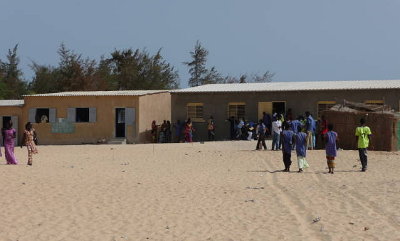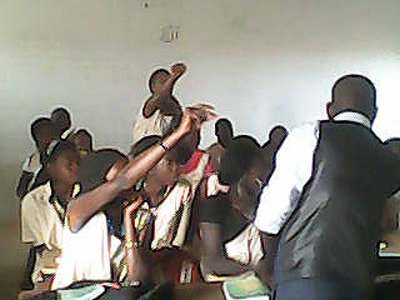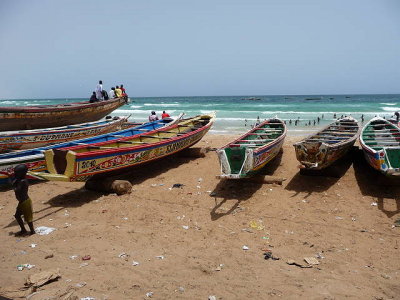The CEM Cayar seeks international partners
 The middle school (collège d'enseignement moyen, CEM) in Cayar is a public mixed teaching institution with nearly five hundred (500) pupils, of whom 245 boys and 255 girls. The teaching staff is composed of 13 members for literary and scientific disciplines and three supervisors providing administrative services under the oversight of the Principal, Mr Abibou Diop, a graduate in langues holding a Modern English DEPA.
The middle school (collège d'enseignement moyen, CEM) in Cayar is a public mixed teaching institution with nearly five hundred (500) pupils, of whom 245 boys and 255 girls. The teaching staff is composed of 13 members for literary and scientific disciplines and three supervisors providing administrative services under the oversight of the Principal, Mr Abibou Diop, a graduate in langues holding a Modern English DEPA.
Located in the Department of Thies in the region of the same name and in the municipality of Cayar, the College accommodates a majority of students from the traditional village of Cayar as well as school boys from the villages Mbawane, Keur Abdou Ndoye and Ndiokhop, localities some two to maximum four km away from Cayar. All pupils have the same nationality, but belong to different ethnic groups, Wolof and especially Lebou, who are often fishermen and minorities experienced in livestock and horticulture.
 The 13 teachers provide general education that includes the scientific disciplines (mathematics, life and earth sciences, physics). The courses are theoretical, because the school has no laboratory or scientific equipment that would allow practice and experimental workshops. Among its shortcomings, we should note the absence of a website and a professor of art education. But the artistic activities of the school are framed by two great names in Senegalese art, namely Samba Laye Diop of the Arts Village in Dakar, and Abdoulaye Seck, well-known to have held numerous art exhibitions in Europe. The school can also count on the collaboration of professors from other art education institutions including the Bayakh High School. Sport occupies a prominent place in the College. In addition to modern sports, traditional wrestling is practiced.
The 13 teachers provide general education that includes the scientific disciplines (mathematics, life and earth sciences, physics). The courses are theoretical, because the school has no laboratory or scientific equipment that would allow practice and experimental workshops. Among its shortcomings, we should note the absence of a website and a professor of art education. But the artistic activities of the school are framed by two great names in Senegalese art, namely Samba Laye Diop of the Arts Village in Dakar, and Abdoulaye Seck, well-known to have held numerous art exhibitions in Europe. The school can also count on the collaboration of professors from other art education institutions including the Bayakh High School. Sport occupies a prominent place in the College. In addition to modern sports, traditional wrestling is practiced.
The ability to go to school is open to all, even if some students are having difficulties in the management of transportation for students living in remote villages. Yet many students struggle to go beyond the mid-level cycle for lack of resources, particularly girls are often forced into early marriage or as a result of the parents' reluctance to allow girls to conduct studies that lead them away from the family context.
The overwhelming majority of pupils attending the College are children of fishermen, farmers and herders of a once prosperous village in the image of its founding myth, which had the town as a land of abundance and profusion translated into local Kaar yi yaar. A devastating cycle of droughts experienced during the decade of the 1970s and overfishing have definitely entrenched poverty and insecurity in the Niayes (swamp lands suitable for horticulture) that line the coast of Senegal in West Africa, from Dakar to St Louis.
 The general economic situation is not promising, because so far focused mainly on fishing in the sea, which has been emptied of its marine resource treasury; few alternatives to fishing are available to young people who do not have sufficient education and training allowing them to exercise other economic activities - thus the idea of embarking on illegal emigration despite the recession in Europe.
The general economic situation is not promising, because so far focused mainly on fishing in the sea, which has been emptied of its marine resource treasury; few alternatives to fishing are available to young people who do not have sufficient education and training allowing them to exercise other economic activities - thus the idea of embarking on illegal emigration despite the recession in Europe.
90% of the households in Cayar are polygamous and there is a large juvenile population with high demand for schooling, which outpaces most forecasters' statistics. All this unfolds in the face of a financially weak public authority and citizens who are still not aware of the stakes of education and schooling for getting out of poverty and precariousness. This school, while recognised by those thinking ahead as the safest investment for solutions to the crisis and alternative offers of building a spirit of sustainability, suffers from an acute lack equipment: weak hosting capacity of the College, no library, lack of electricity, running water, sanitation, school feeding and other socio-educational facilities to provide a framework that ensures academic success for each student.
 The Parents' Association (APE) is dynamic, but lacks capacity and can not achieve major actions despite its goodwill and its constant, but unheard, calls to the authorities of the central government.
The Parents' Association (APE) is dynamic, but lacks capacity and can not achieve major actions despite its goodwill and its constant, but unheard, calls to the authorities of the central government.
In terms of partnerships, the College of Cayar has not yet found a government engaged in a decisive collaboration.
WWF signals opportunities for collaboration, but none has yet been formalised and developed with a proper business plan. A framework for an exchange seemed to be reached with the European School
Brussels 1, but it is slow to develop continuity.
The CEM Cayar is particularly concerned about problems, such as the degradation of the marine and coastal environment, given our specificity of people of the sea and living with the sea. This is why information and awareness sessions have been held with environment technicians, including of the Water and Forestry Service and the curator of the Marine Protected Area.
 These exchanges were designed to educate pupils on the basis of their own experiences. Then artistic meetings were held to enable pupils to translate through artistic expression the various topics discussed during the meetings. The participations in the exhibition in the occasion of the 50th anniversary of the European School in Brussels and in the exhibition organised in the context of the international Conference on the People of the Sea, "Sustainable Seas Through the Eyes of Art", created much animation for our students, who have produced works for these occasions. Currently, we are working for an outdoor exhibition on the beach at the foot of the waves dying to Cayar. The topics to be exposed are related to gear conflicts between fishermen using different fishing techniques, sand mining and beach pollution.
These exchanges were designed to educate pupils on the basis of their own experiences. Then artistic meetings were held to enable pupils to translate through artistic expression the various topics discussed during the meetings. The participations in the exhibition in the occasion of the 50th anniversary of the European School in Brussels and in the exhibition organised in the context of the international Conference on the People of the Sea, "Sustainable Seas Through the Eyes of Art", created much animation for our students, who have produced works for these occasions. Currently, we are working for an outdoor exhibition on the beach at the foot of the waves dying to Cayar. The topics to be exposed are related to gear conflicts between fishermen using different fishing techniques, sand mining and beach pollution.
Our collaboration with Mundus maris s is not quite direct, because Aliou Sall served always as an intermediary and support for all our actions. A mission by Carla Zickfeld visited us and we also participated in a Workshop in Dakar on Climate Change - Vision 2050. We hope to benefit more from technical and pedagogical support of Mundus maris.
The College of Cayar is overseen by a Principal who, from his scout experience, is very committed to ecological concerns. He is a strong supporter of the concept - School 'Arts and Sciences for a Sustainable Economy' - he provides institutional and pedagogical support for teachers and students participating in the activities. What should be supported in Cayar is above all a strenthening of the scientific and educational school environment.
Expectations are especially in terms of equipment and teaching materials to better educate students and allow them an artistic expression serving the protection of the environment and sustainability. Accompanying papers will follow.
For firm collaboration and commitment.
Mr Abibou DIOP
Principal of the CEM Cayar, April 2011
For direct contact: Esta dirección de correo electrónico está siendo protegida contra los robots de spam. Necesita tener JavaScript habilitado para poder verlo.








